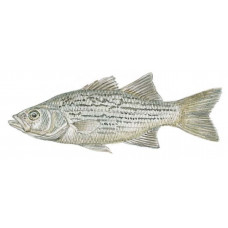Latin name
Morone saxatilis x Morone chrysops
Other names
Hybrid striped bass, wiper.
Identification
This fish looks like a chunkier version of striped bass, usually smaller lengths and more girth, but very similar in coloration. The whiterock can be distinguished from sunshine bass primarily by less distinct, discontinuous, or broken lines along the sides. The lateral lines of the parent fish are not interrupted. Hybrid stripers (and purebred stripers) can be distinguished from white bass by the pattern of teeth on their tongues. White bass has one broad U-shaped pattern, while striper has two distinctive elongated teeth. It is important to know the differences between these fish when fishing in waters where all three species may be present, as the rules for their fishing may differ.
Distribution
The distribution of hybrid striped bass is limited to freshwater and areas with good populations of bait fish, mostly members of the herring family. Nevertheless, stocking programs have led to the planting of these fish in lakes and reservoirs in more than 30 states, from California to New York and from Nebraska to Florida. The greatest concentration is in the southern half of the country, and the greatest fishing opportunities are in the Southeast.
Habitat
Whiterock and sunshine bass inhabit the same freshwater habitats as their parents, mostly in large lakes and reservoirs, also thriving in medium and large rivers and sometimes in small lakes or ponds. In these environments, they mostly roam and are found in the same places as their parents, sometimes mingling with them, mostly in open water or in the tail of dams. They are rarely found near shore, docks, or piers, except when chasing flocks of bait fish.
Size
Whiterock and sunshine bass have an extremely fast growth rate in the early stages of development. Those specimens that have been stocked as one-inch fish grow to 4 inches in just 1 month and up to 15 inches by the second summer, so they quickly reach sizes of interest to anglers. At 18 inches long, hybrid striper weigh at least 3 pounds and possibly up to 5 pounds. Their maximum attainable size is unknown, although they grow much larger than white bass and much smaller than pure striped bass. The world record holder of all tackle is the hybrid-striped bass from Alabama, weighing 25 pounds 15 ounces.
Life history and Behavior
These elements are essentially the same as those of the parent species, including spring spawning, open water migrations, schooling habits, and tendency to take bait. The difference between whiterock and sunshine bass is that when planted in lakes where there are no other related species to cross with, they can be fully controlled by stocking programs. Unlike many hybrid fish that are sterile, these individuals are fertile fish. They can only reproduce by crossing with parents of the pure species. But in lakes where there are no pure-strain stripers or white bass (usually in northern states), fishery managers stock hybrid striped bass, confident that the fish will not spread outside the stocked area. That way, if the fish will be harmful to the bait fish or other game species, it could be eliminated by stopping the stocking.
Food and feeding habits
Food preferences and feeding habits of these fish are similar to those of freshwater striped bass and white bass.
Reproduction
No information
| Classification | |
| Phylum | Chordata |
| Class | Actinopterygii |
| Squad | Perciformes |
| Family | Moronidae |
| Genus | Morone |
| Species | M. chrysops × M. saxatilis |
| Features | |
| Conservation status | No information |
| Habitat | Pelagic |
| Life span, years | No information |
| Maximum body weight, kg | 22.7 |
| Maximum length, cm | No information |
| Sailing speed, m/s | No information |
| Threat to people | Edible |
| Way of eating | Predator |

